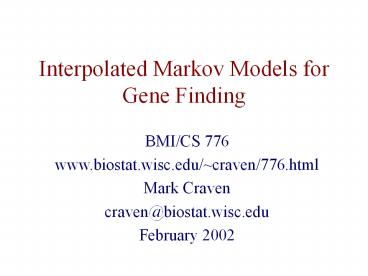Interpolated Markov Models for Gene Finding - PowerPoint PPT Presentation
Title:
Interpolated Markov Models for Gene Finding
Description:
encoding a protein affects the statistical properties of a DNA sequence ... Markov Chain Model ... for modeling DNA we need parameters for an nth order model ... – PowerPoint PPT presentation
Number of Views:197
Avg rating:3.0/5.0
Title: Interpolated Markov Models for Gene Finding
1
Interpolated Markov Models for Gene Finding
- BMI/CS 776
- www.biostat.wisc.edu/craven/776.html
- Mark Craven
- craven_at_biostat.wisc.edu
- February 2002
2
Announcements
- HW 1 out due March 11
- class accounts ready
- quasar-1.biostat.wisc.edu, quasar-2.biostat.wisc.e
du - class mailing list ready
- bmi776_at_biostat.wisc.edu
- please check mail regularly and frequently, or
forward it to wherever you can do this most
easily - reading for next week
- Bailey Elkan, The Value of Prior Knowledge in
Discovering Motifs with MEME (on-line) - Lawrence et al., Detecting Subtle Sequence
Signals A Gibbs Sampling Strategy for Multiple
Alignment (handed out in class) - talk tomorrow
- Bioinformatics Tools to Study Sequence Evolution
Examples from HIV - Keith Crandall, Dept. of Zoology, BYU
- 10am, Thursday 2/28
- Biotech Center Auditorium (425 Henry Mall)
3
Approaches to Finding Genes
- search by sequence similarity find genes by
looking for matches to sequences that are known
to be related to genes - search by signal find genes by identifying the
sequence signals involved in gene expression - search by content find genes by statistical
properties that distinguish protein-coding DNA
from non-coding DNA - combined state-of-the-art systems for gene
finding combine these strategies
4
Gene Finding Search by Content
- encoding a protein affects the statistical
properties of a DNA sequence - some amino acids are used more frequently than
others (Leu more popular than Trp) - different numbers of codons for different amino
acids (Leu has 6, Trp has 1) - for a given amino acid, usually one codon is used
more frequently than others - this is termed codon preference
- these preferences vary by species
5
Codon Preference in E. Coli
AA codon /1000 ---------------------- Gly
GGG 1.89 Gly GGA 0.44 Gly
GGU 52.99 Gly GGC 34.55 Glu
GAG 15.68 Glu GAA 57.20 Asp
GAU 21.63 Asp GAC 43.26
6
Search by Content
- common way to search by content
- build Markov models of coding noncoding regions
- apply models to ORFs or fixed-sized windows of
sequence - GeneMark Borodovsky et al.
- popular system for identifying genes in bacterial
genomes - uses 5th order inhomogenous Markov chain models
7
Reading Frames
8
Reading Frames
- a given sequence may encode a protein in any of
the six reading frames
9
Markov Models Reading Frames
- consider modeling a given coding sequence
- for each word we evaluate, well want to
consider its position with respect to the reading
frame were assuming
10
A Fifth Order Inhomogenous Markov Chain
AAAAA
start
TACAA
TACAC
TACAG
TACAT
TTTTT
position 1
position 2
position 3
11
Selecting the Order of a Markov Chain Model
- higher order models remember more history
- additional history can have predictive value
- example
- predict the next word in this sentence fragment
finish __ (up, it, first, last, ?)
- now predict it given more history
Nice guys finish __
12
Selecting the Order of a Markov Chain Model
- but the number of parameters we need to estimate
grows exponentially with the order - for modeling DNA we need
parameters for an nth order model - the higher the order, the less reliable we can
expect our parameter estimates to be - estimating the parameters of a 2nd order
homogenous Markov chain from the complete genome
of E. Coli, wed see each word gt 72,000 times on
average - estimating the parameters of an 8th order chain,
wed see each word 5 times on average
13
Interpolated Markov Models
- the IMM idea manage this trade-off by
interpolating among models of various orders - simple linear interpolation
- where
14
Interpolated Markov Models
- we can make the weights depend on the history
- for a given order, we may have significantly more
data to estimate some words than others - general linear interpolation
15
The GLIMMER System
- Salzberg et al., 1998
- system for identifying genes in bacterial genomes
- uses 8th order, inhomogeneous, interpolated
Markov chain models
16
IMMs in GLIMMER
- how does GLIMMER determine the values?
- first, lets express the IMM probability
calculation recursively
17
IMMs in GLIMMER
- if we havent seen more than
400 times, then compare the counts for the
following
nth order history base
(n-1)th order history base
- use a statistical test ( ) to get a value d
indicating our confidence that the distributions
represented by the two sets of counts are
different
18
IMMs in GLIMMER
- putting it all together
where
19
GLIMMER Experiment
- 8th order IMM vs. 5th order Markov model
- trained on 1168 genes (ORFs really)
- tested on 1717 annotated (more or less known)
genes
20
Accuracy Metrics
actual class
positive
negative
false positives (FP)
true positives (TP)
positive
predicted
true negatives (TN)
false negatives (FN)
negative
21
GLIMMER Results
TP
FN
FP
GLIMMER
5th Order































